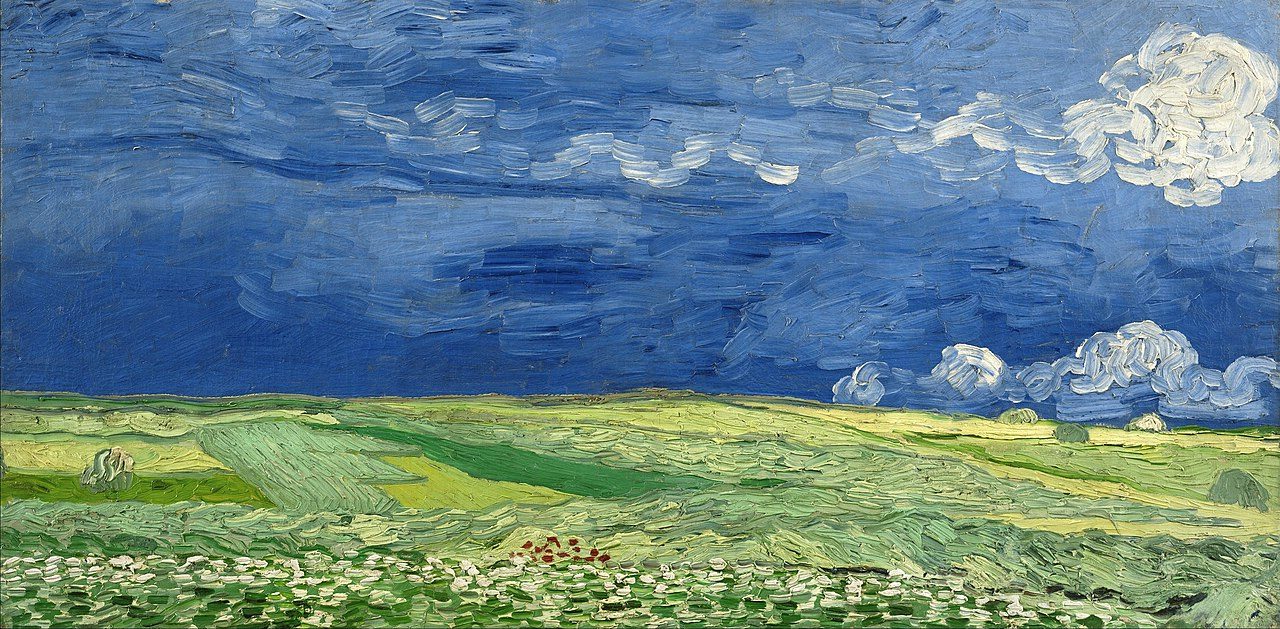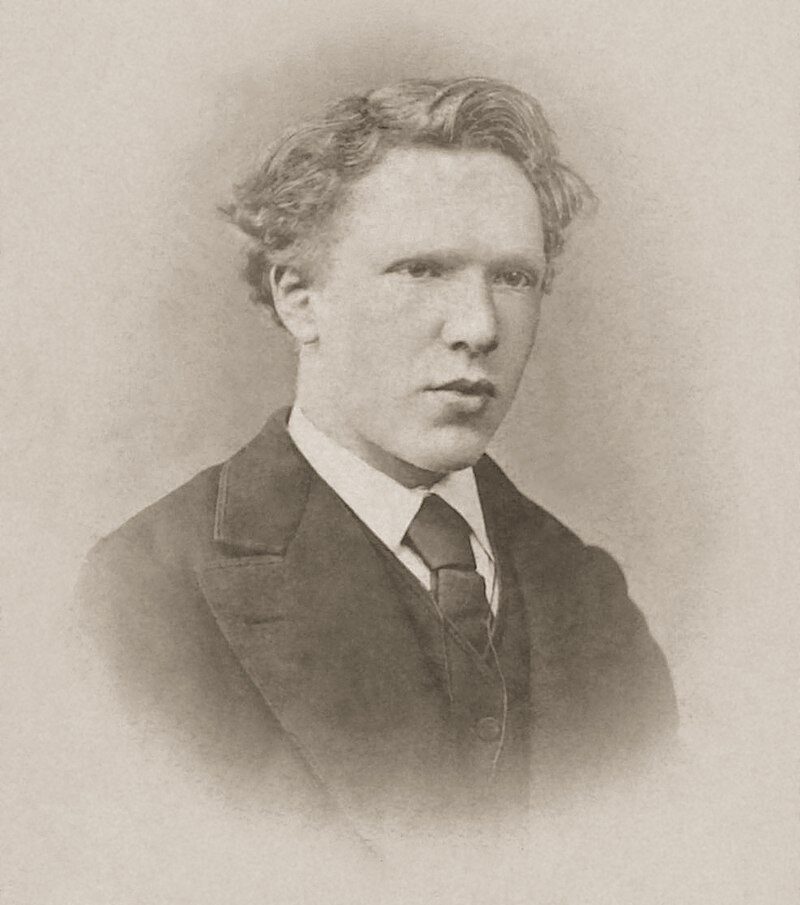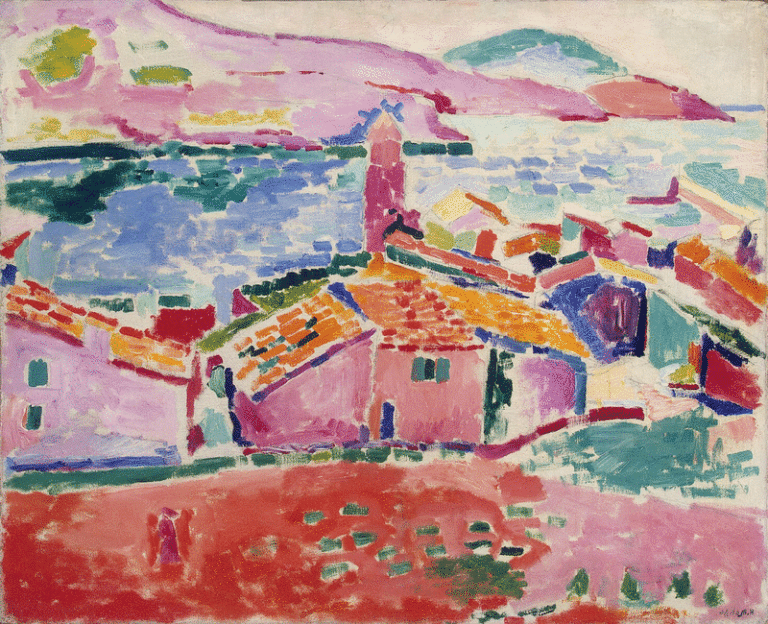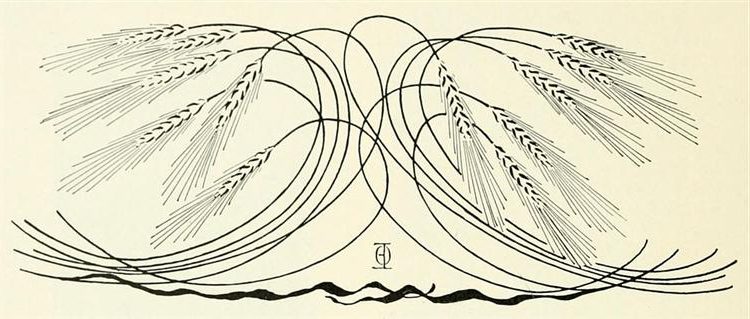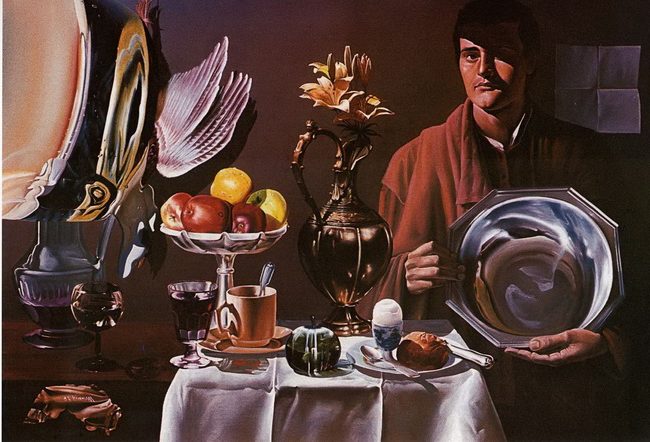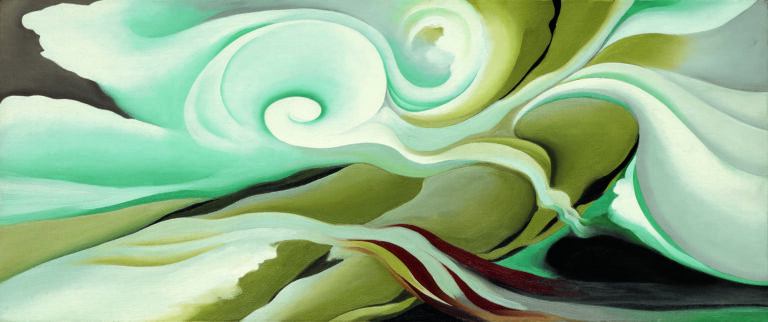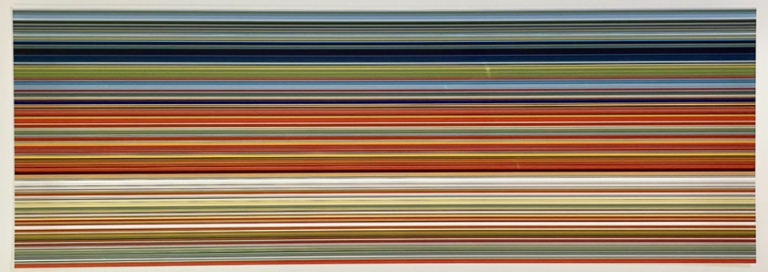Vincent van Gogh: Painter Who Revolutionized Post-Impressionist Art
Born: 30 March 1853, Zundert, Netherlands
Death: 29 July 1890, Auvers-sur-Oise, France
Art Movement: Post-Impressionism
Nationality: Dutch
Teacher: Willem Roelofs
Institution: Académie Royale des Beaux-Arts
Vincent van Gogh: Painter Who Revolutionized Post-Impressionist Art
Life and Work of Vincent van Gogh
Vincent van Gogh created approximately 2,100 artworks in just over a decade. His bold colors, dramatic brushwork, and emotional depth revolutionized art, despite achieving little recognition during his lifetime.
Early Life and Family
Vincent Willem van Gogh was born on March 30, 1853, in Zundert, Netherlands. He was the oldest surviving child of Theodorus van Gogh, a minister, and Anna Cornelia Carbentus.
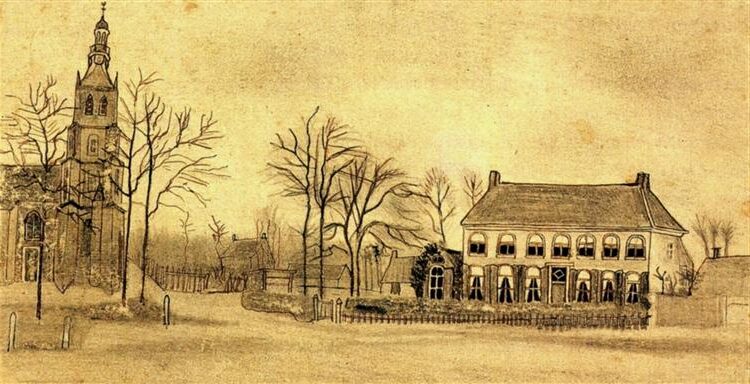
Vicarage and Church at Etten (1876) by Vincent van Gogh
His younger brother Theo became his closest confidant and financial supporter throughout his life. Their bond is documented in over 600 letters that provide valuable insights into Vincent’s thoughts and artistic process.
As a child, Vincent was serious, quiet, and thoughtful. He attended several schools but struggled to find direction early in life.
Before pursuing art, Vincent worked various jobs including as an art dealer at Goupil & Cie, a teacher, and a missionary. These experiences shaped his perspective and later influenced his artistic subjects.
Artistic Beginnings and Development
Van Gogh began drawing seriously in his late twenties, making a late start as an artist in 1880. He initially taught himself by copying prints and studying drawing manuals.
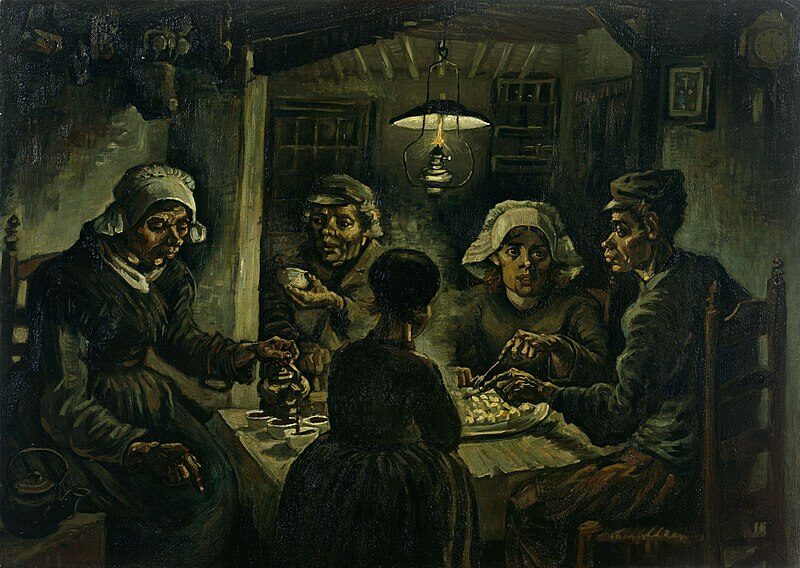
The Potato Eaters (c. 1885) by Vincent van Gogh
His early work featured dark, somber colors and depicted peasant life. “The Potato Eaters” (1885) exemplifies this early period with its dark palette and focus on rural hardship.
In 1886, Van Gogh moved to Paris where he encountered Impressionist and Post-Impressionist styles. This exposure dramatically transformed his art.
His palette brightened significantly after studying Japanese prints and meeting artists like Henri de Toulouse-Lautrec and Paul Gauguin. His brushwork became more expressive and his use of color more emotional rather than realistic.
Van Gogh developed his unique style characterized by:
- Bold, visible brushstrokes
- Vibrant, symbolic colors
- Strong emotional content
- Distortion for expressive effect
Significant Life Events and Mental Health
Van Gogh’s mental health struggles profoundly affected his life and work. He experienced episodes of depression, anxiety, and psychotic symptoms throughout his adult life.
The infamous ear incident occurred in December 1888 in Arles, France. Following an argument with Gauguin, Vincent cut off part of his own ear and delivered it to a local brothel.
After this breakdown, he voluntarily entered the Saint-Paul-de-Mausole asylum in Saint-Rémy in May 1889. During his year-long stay, he created some of his most famous works including “Starry Night.”
Despite his struggles, this period was incredibly productive. Van Gogh created about 150 paintings while in the asylum, channeling his emotional turmoil into his art.
On July 29, 1890, at age 37, Van Gogh died from a self-inflicted gunshot wound. His final years were his most productive artistically, creating an average of one painting every 36 hours.
Artistic Style and Techniques
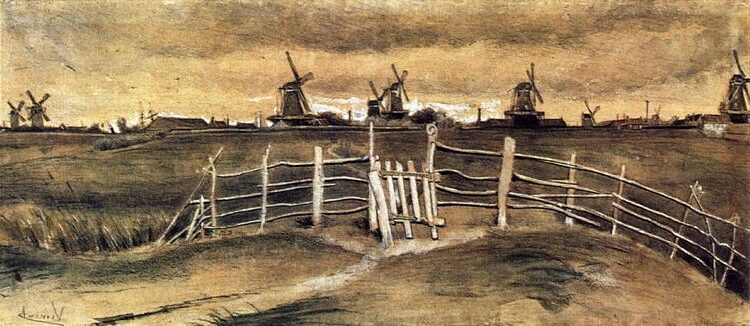
Windmills at Dordrecht (1881) by Vincent van Gogh
Van Gogh developed a distinctive artistic style characterized by bold colors, expressive brushwork, and emotional intensity. His technical approach evolved dramatically during his short career, moving from dark, earthy tones to vibrant, symbolic color choices that would influence generations of artists.
Color Theory and Palette
Van Gogh’s use of color evolved significantly throughout his career. Early works featured dark, somber tones influenced by Dutch masters. After moving to Paris in 1886, his palette brightened dramatically upon encountering Impressionist and Japanese artwork.
He developed theories about color relationships, often placing complementary colors side by side to enhance their intensity. Yellow became particularly significant in his work, symbolizing warmth, hope, and sunlight.
In paintings like “Sunflowers” and “Starry Night,” Van Gogh used bold yellows against blues and violets to create vibrant visual tension. His color choices were emotional rather than realistic, expressing inner feelings rather than literal representation.
Van Gogh often applied colors straight from the tube rather than mixing them extensively, contributing to the vibrant, almost electric quality of his later works.
Brushwork and Texture
Van Gogh’s distinctive brushwork became one of his most recognizable characteristics. He developed a technique of short, rhythmic brushstrokes that created movement and energy on the canvas.
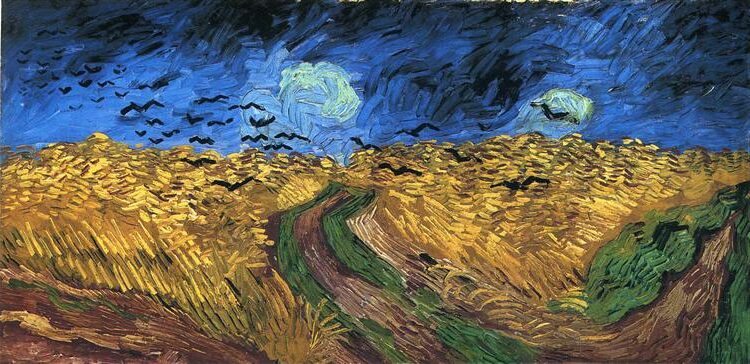
Wheatfield with Crows (1890) by Vincent van Gogh
His paint application was thick and textured, a technique called impasto. This approach gave his paintings a three-dimensional quality, with paint sometimes rising several millimeters from the canvas surface.
In works like “Wheatfield with Crows,” brushstrokes follow the contours of the landscape, enhancing the emotional impact. His cypresses seem to flame upward through swirling, dynamic strokes.
Van Gogh painted quickly and intuitively, often completing a canvas in a single day. This rapid execution contributed to the expressive, emotional quality of his work.
His brushwork evolved to include dots, dashes, swirls, and comma-like strokes that captured light, movement, and emotional intensity simultaneously.
Influences and Contemporaries
Van Gogh drew inspiration from diverse sources throughout his artistic development. Japanese ukiyo-e prints profoundly influenced his compositional strategies and use of bold outlines.
He admired Jean-François Millet’s dignified portrayals of peasant life. This influence is evident in works like “The Potato Eaters,” though Van Gogh’s interpretation was more emotionally charged.
Among his contemporaries, Van Gogh formed a brief but significant relationship with Paul Gauguin. Their time together in Arles proved artistically stimulating but personally tumultuous.
The Impressionists, particularly Claude Monet, influenced Van Gogh’s use of brighter colors and outdoor painting. However, Van Gogh pushed beyond Impressionism toward a more expressive, emotional approach.
Van Gogh also studied Pointillist techniques from artists like Georges Seurat, though he adapted these into his more emotionally expressive style rather than pursuing scientific precision.
Legacy and Impact on Art
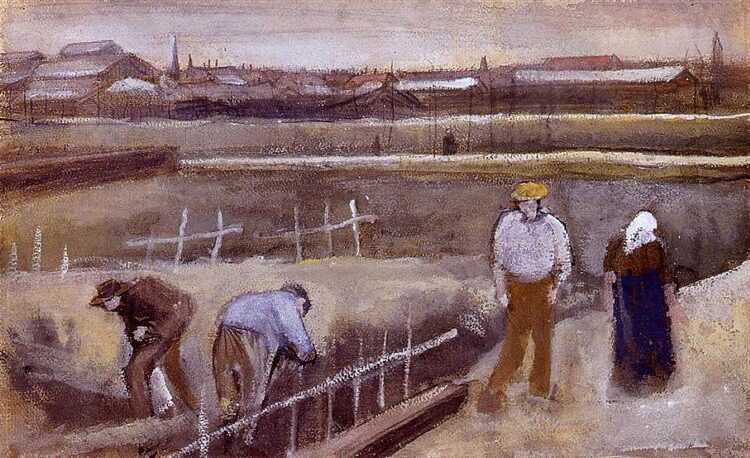
Meadows near Rijswijk (1882) – Vincent van Gogh
Vincent van Gogh’s artistic influence extends far beyond his lifetime, transforming from obscurity to becoming one of history’s most celebrated painters. His bold techniques and emotional expression changed the course of Western art forever.
Posthumous Recognition
Van Gogh achieved almost no recognition during his lifetime. He sold only one painting while alive – “The Red Vineyard” – for a modest sum. His sister-in-law Johanna van Gogh-Bonger played a crucial role in promoting his work after his death in 1890.
By the early 1900s, his paintings began appearing in major exhibitions across Europe. The 1905 retrospective at the Stedelijk Museum in Amsterdam marked a turning point in public perception.
Today, Van Gogh ranks among the most famous artists in history. His paintings command record-breaking prices at auctions, with “Portrait of Dr. Gachet” selling for $82.5 million in 1990 (equivalent to about $178 million today).
Major Works and Their Locations

The Starry Night (June 1889) by Vincent van Gogh
Van Gogh’s most celebrated works are displayed in prestigious museums worldwide:
| Painting | Year | Current Location |
|---|---|---|
| Starry Night | 1889 | Museum of Modern Art, New York |
| Sunflowers (series) | 1888-1889 | Various museums including Van Gogh Museum |
| Self-Portrait with Bandaged Ear | 1889 | Courtauld Gallery, London |
| Irises | 1889 | J. Paul Getty Museum, Los Angeles |
| The Potato Eaters | 1885 | Van Gogh Museum, Amsterdam |
The Van Gogh Museum in Amsterdam houses the largest collection of his works with over 200 paintings and 500 drawings. His art attracts millions of visitors annually to museums around the world.
Influence on Modern Art
Van Gogh’s revolutionary approach to color and brushwork directly influenced major art movements like Fauvism and Expressionism. His emotional intensity and personal vision helped shift art away from realistic representation toward subjective expression.

Orphans (1882) by Vincent van Gogh
Artists like Matisse, Gauguin, and the German Expressionists adopted elements of his distinctive style. His bold color choices and thick, visible brushstrokes became hallmarks of modern painting.
His honest portrayal of mental illness through art also pioneered the concept of art as emotional therapy. This perspective remains influential in art therapy approaches today.
Van Gogh’s letters to his brother Theo provided valuable insights into his creative process, influencing how later artists approached their work and artistic philosophy.
Frequently Asked Questions
Vincent van Gogh left behind many fascinating aspects of his artistic career and personal life that continue to intrigue art enthusiasts. His distinctive style, prolific periods, and lasting influence raise common questions among those studying his work.
What are the defining characteristics of Vincent van Gogh’s painting style?
Van Gogh’s painting style featured bold, expressive brushstrokes that created texture and movement. He used vibrant, non-naturalistic colors to convey emotion rather than reality.
His work often displayed thick application of paint, known as impasto, which gave his canvases a three-dimensional quality. This technique is especially visible in works like “Starry Night” where the swirling sky seems to move.
Van Gogh also employed strong outlines and distinctive contours around objects. His unique perspective and compositional choices created a sense of immediacy and emotional intensity.
Which period of Van Gogh’s work is considered his most prolific and why?
Van Gogh’s time in Arles, France (1888-1889) marks his most prolific period. During these months, he created over 200 paintings, including some of his most famous works.
The bright Mediterranean light inspired his shift to more vibrant colors and bold compositions. His mental health had temporarily improved, allowing for intense creative output.
This period saw the creation of masterpieces like “Sunflowers,” “The Yellow House,” and “Café Terrace at Night.” His style fully matured during this time, establishing what we now recognize as his signature approach.
Can you describe the significance of the ‘Sunflowers’ series in Van Gogh’s oeuvre?
The “Sunflowers” series represents Van Gogh’s mastery of color and composition. He created multiple versions between 1887-1889, with the most famous being the yellow background variations.
These paintings served as decoration for the Yellow House in Arles where Paul Gauguin stayed. Van Gogh saw sunflowers as symbols of gratitude and friendship.
The series demonstrates his innovative use of yellows and oranges, creating variations in a single color palette. These works have become some of the most recognizable and valuable paintings in art history.
How did Van Gogh’s mental health struggles influence his artwork?
Van Gogh’s mental health challenges directly influenced his artistic expression. During periods of crisis, his work often displayed more turbulent brushwork and intensified colors.
After cutting his ear in December 1888, his self-portraits reflected his vulnerability and psychological state. His time at the Saint-Rémy asylum produced emotionally charged works like “Starry Night.”
Despite his suffering, Van Gogh found art therapeutic. He often painted during periods of lucidity between episodes, creating some of his most powerful works while processing his experiences.
What impact did Van Gogh have on the post-impressionist movement and modern art?
Van Gogh helped pioneer Post-Impressionism by moving beyond the light-focused approach of Impressionism toward emotional expression. His work emphasized personal feeling over accurate representation.
His bold use of color and form influenced early 20th-century movements like Fauvism and Expressionism. Artists like Matisse and the German Expressionists drew direct inspiration from his approach.
Though unrecognized in his lifetime, Van Gogh’s innovations in using color to express emotion rather than reality transformed modern art. His willingness to distort reality for emotional impact became fundamental to 20th-century artistic development.
Which of Van Gogh’s works are considered his masterpieces, and where can they be viewed today?
“Starry Night” (1889) stands as Van Gogh’s most recognized masterpiece. It hangs in the Museum of Modern Art in New York.
“Sunflowers” can be viewed at London’s National Gallery.
“The Potato Eaters” (1885), representing his early darker period, is displayed at the Van Gogh Museum in Amsterdam. This museum holds the world’s largest collection of his works.
Other masterpieces include “Café Terrace at Night” (Kröller-Müller Museum, Netherlands), “Irises” (Getty Center, Los Angeles), and “The Bedroom” (Art Institute of Chicago). His self-portraits are distributed among major museums worldwide.

